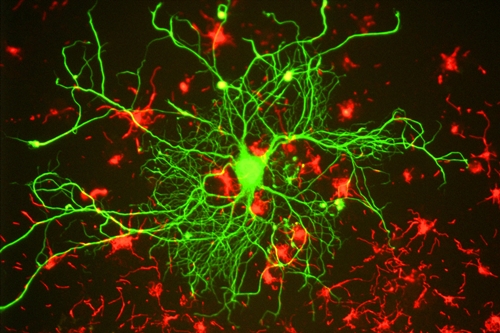20 July 2015. A drug developed to treat Alzheimer’s disease reduced a large percentage of accumulated harmful peptides and proteins in brains of laboratory mice induced with the disorder. Results of the tests were reported today by the biotechnology company Treventis Corp. in Philadelphia, developer of the drug code-named TRV-101.
Alzheimer’s disease is progressive neurodegenerative disease affecting growing numbers of older people worldwide. The disorder slowly destroys memory and cognitive skills, eventually affecting the ability to carry out even simple day-to-day tasks. Alzheimer’s Foundation of America estimates some 5.1 million people in the U.S. may have Alzheimer’s disease, including a 500,000 under the age of 65. In families with Alzheimer’s disease, 1 to 4 individuals act as caregivers.
People with Alzheimer’s disease often have deposits of abnormal substances in spaces between brain cells, known as beta-amyloid peptides, as well as misfolded tangles of proteins inside brain cells known as tau. Beta-amyloid peptides accumulate in spaces between brain cells in aggregate formations known as oligomers. As the oligomer accumulations enlarge they interfere with synapses and receptors on neighboring cells, affecting their ability to function. It is not yet conclusively established, however, if beta-amyloid deposits are the result of Alzheimer’s disease or a cause of it.
Tau is a protein containing phosphate molecules found in healthy brain cells that stabilize the support channels inside the cells. In Alzheimer’s disease, however, tau proteins gain more phosphate molecules, causing them to break off and accumulate inside the brain cells, becoming tangled in thread-like formations. These formations can change the three-dimensional shape of the protein, a process known as misfolding, that damage the support channels in brain cells, impairing their ability to signal other brain cells.
Treventis says TRV-101 is a small molecule, or low molecular weight, compound designed to be taken orally that counteracts accumulations of beta-amyloid and tau. The company says the drug candidate was discovered through its own computational model that simulates self-associating accumulations and protein misfolding, with potential effectiveness of TRV-101 highlighted in lab tests, including tests with animals.
In the tests reported today, lab mice induced with Alzheimer’s disease were fed TRV-101 over 3 to 7-day periods. Treventis says the mice were found to have 30 to 40 percent lower levels of beta-amyloid oligomers and tau deposits after the test periods. In addition, the mice did not show ill effects from the treatments.
Treventis Corp. was founded by two Canadian scientists, Sultan Darvesh at Dalhousie University in Halifax, Nova Scotia and Donald Weaver, director of Toronto Western Research Institute. Weaver continues at the company’s chairman. Early development of TRV-101 is supported by a grant from the Wellcome Trust, with a first clinical trial planned for next year.
Read more:
- Alzheimer’s Drug Granted Orphan Status for Fragile X
- Trial Shows Current Drug Slows Alzheimer’s Onset
- Foundation, Pfizer Collaborate on Alzheimer’s Targets
- Trial to Test Drug to Delay Early-Onset Alzheimer’s
- European Consortium to Create Alzheimer’s Trial Panel
* * *


 RSS - Posts
RSS - Posts
[…] Early Test Shows Alzheimer’s Candidate Lowers Brain Deposits […]